Remote Medical International: An Amazing Contributor to North Cascades Institute
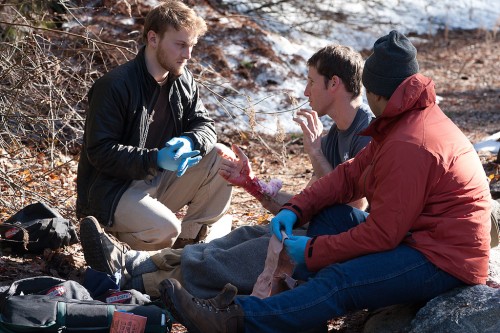 Assuming you studied the 2011 North Cascades Institute catalog closely, you may have noticed the lack of activities available at the Environmental Learning Center during the winter. As the studious person you are, the next obvious conclusion you would draw is that we close our doors, descend into hibernation, and wait for the snow to melt before inviting guests to join us again in the spring. However, all winter long, our campus is full of activity and guests.
Assuming you studied the 2011 North Cascades Institute catalog closely, you may have noticed the lack of activities available at the Environmental Learning Center during the winter. As the studious person you are, the next obvious conclusion you would draw is that we close our doors, descend into hibernation, and wait for the snow to melt before inviting guests to join us again in the spring. However, all winter long, our campus is full of activity and guests.
In fact, on any given day, the Environmental Learning Center could be a scene of mass panic and chaos. You might see a dozen or more patients strewn about campus, screaming in pain, with an equal number of rescuers downing latex gloves, warm clothes, and nervous enthusiasm there to stabilize them.
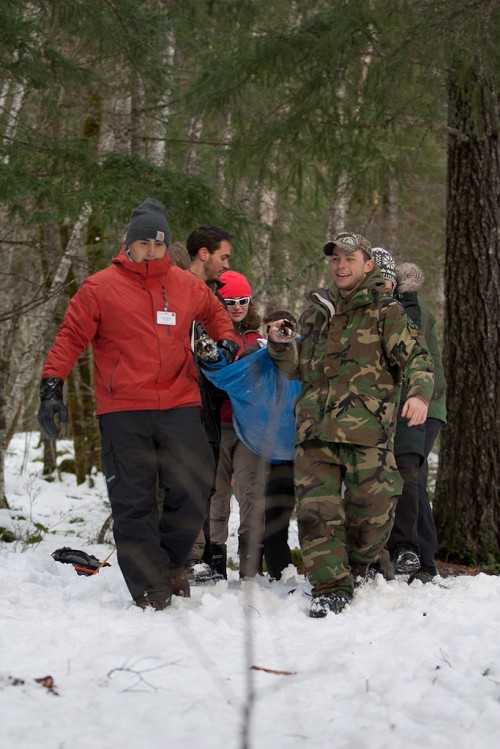 WEMT students learn to improvise ways to transport patients out of the backcountry in makeshift litters.
WEMT students learn to improvise ways to transport patients out of the backcountry in makeshift litters.
Practicing newly learned wilderness medical skills, these victims and rescuers are all students in a Wilderness Emergency Medical Technician (WEMT) course held here by Remote Medical International (RMI) through North Cascades Institute’s Group Rentals Program.
For the uninitiated, Group Rentals provides a way for groups of all kinds to utilize our campus and staff for events from business meetings to weddings. It provides the Institute a tool for expanding the impact of our mission to individuals that may not otherwise consider attending our programs. It is also a means of generating earned income to support all the other amazing youth programs that we offer throughout the summer, fall, and winter seasons.
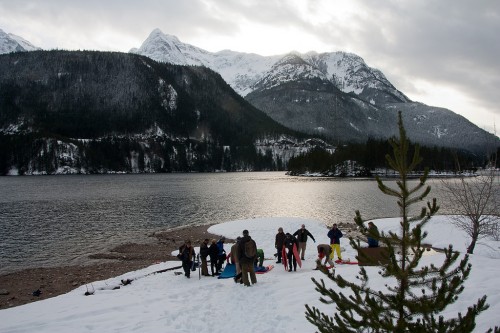 WEMT students practice medical skills on the shores of Diablo Lake.
WEMT students practice medical skills on the shores of Diablo Lake.
Remote Medical International is one of our largest Group Rentals clients. As a medical and rescue services company specializing in remote areas, they provide equipment, training, telemedicine, and onsite medical care for anyone who works or plays where quick access to a hospital is not an option. Annually, RMI contributes over a significant amount of funds to the North Cascades Institute, and provides additional wilderness medical training for our staff at no charge.
In exchange, we provide over 60 days of use of Environmental Learning Center facilities and meals during the seven trainings offered here throughout the year. The WEMT, a 26-day course, is by far the longest of RMI courses held at our campus. The only other way to spend that much time immersed at the Environmental Learning Center is to work or study here.
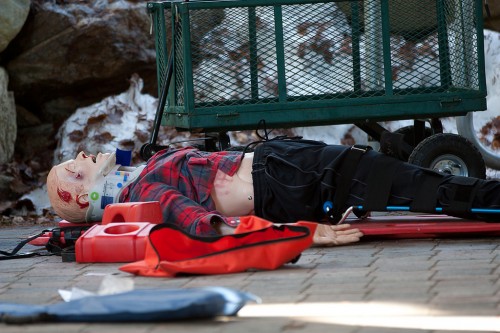 A dummy used during RMI scenario-based learning practicums.
A dummy used during RMI scenario-based learning practicums.
The third Sunday in January marks the start of this month-long WEMT experience, a hands-on course in managing emergencies in remote settings. Students of that program receive a combination of classroom lecture and real world scenarios in order to prepare them for making critical decisions when injuries or illnesses occur in areas far away from definitive care. This balance of classroom and scenario-based learning solidifies concepts through immediate application of skills involving fake blood, make up, and great acting. The RMI instructors challenge their students to improve their skills everyday.
You would be hard pressed to find a more experienced collection of wilderness medicine instructors. RMI staff range from mountain guides to special ops veterans, and they are always game to tell a story or two around the dinner table.
Below is an excerpt by North Cascades Institute Seasonal Naturalist, Ryan Weisberg, recalling his experience playing a patient for one of the scenario-based learning practicums of the WEMT course.
We leave our house in the town of Diablo at 1:30 in the morning. Ice sparkles in the snow and the air feels warmer than expected, almost 35 degrees Fahrenheit. We play loud music in the car to help energize us on this middle of the night expedition. We don’t talk much until we reach our destination—Sundew Classroom at the North Cascades Environmental Learning Center. Here, we meet up with RMI instructors and a couple of the WEMT students. One of the instructors gives each of us a big ankle bruise while another briefs us on our back-story that we will act out throughout this night scenario. Then we bundle up and begin hiking into the cold, dark forest.
We hike for about 30 minutes, trying to step in previously lain footprints to avoid post-holing into snow four inches deep, our headlights shining waving beams of soft light into the surrounding darkness. Then we stop. It’s time to spread out and wait for the teams of rescuers. We’re given more instructions about our medical conditions—allergies, vital signs, and related behavior. Then the first patient is placed. It’s me.
I walk off the trail and find a log to sit on while the rest of the group continues hiking. As I sit, my left foot gets caught between two smaller logs I didn’t see. I start trying to figure out how to get my foot out, then realize it’s perfect because my bruise is on that ankle anyways. I now have a story about how it happened. I stop moving and look around. The clean white swath that I think is the trail is barely visible. It’s a full moon tonight, but all I can see through the trees above me are clouds. I look at my watch. It’s 2:45 am.
Ten minutes later I start hearing the shouts of other people coming up the trail. They get louder, and I see the beams of headlights. I get into character by leaning forward so my elbows rest on my knees and begin breathing faster to get my heart rate and respiratory rate up. Then the beams of light are shining in my face and people I can’t see are talking to me, telling me that they’re EMT students and asking if they can help.
I spend the next three hours being treated and entertained by my team of rescuers. They extricate my ankle and get me off the log so I can lie down. They build a makeshift shelter out of a tarp and some rope and tape. There is always someone holding my head because I have indicated that I cannot remember exactly what happened when I got injured, and therefore they cannot immediately rule out a c-spine injury. I stay in character for most of the time, answering their questions about my symptoms and medical history, yelling in pain whenever someone moves my left foot. As time goes on, my vitals signs return to normal and I get less angry and combative. The team has done a good job treating my ailments.
Just after 6:00 am, there’s a call on the radio: “Leave all your gear in place and come back to the trail.” I leave my cocoon-like shelter of the sleeping bag, blanket, and tarp, take the splint off my ankle, and ask where they have put my shoes. We all make our way back to the trail and join the rest of the rescue teams. Completely out of character now, I talk with my rescuers as we walk. As a larger group, we form a big circle and debrief the events of the scenario. Then we start our trek back through the snow, this time in the early light of dawn. We get back just in time for breakfast.
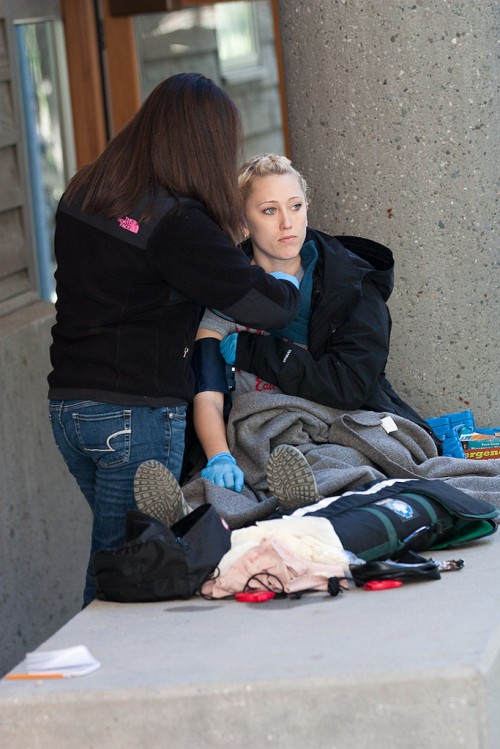 A WEMT student practices long-term patient care.
A WEMT student practices long-term patient care.
There are few programs at the North Cascades Institute that bring as diverse an audience to the Environmental Learning Center than a Group Rental, and Remote Medical International’s courses are no exception. Students come from across the country and, at times, across the globe. As a result, the Institute is able to have a broader global impact on the values people place on nature, while at the same time building revenue to help us create a greater impact locally.
Leading photo of WEMT students as they treat a patient with a trama injury. All photos courtesy of Jess Newley.


Great post! Thanks for the snapshot of the Learning Center in winter. Nice photos and patient excerpt too.